Indigenous futurism and illustration means imagining a future with Indigenous worldviews, governance, landscapes, practices, etc. It would be recreating a world with Indigenous views, not Western ones – like what it was like prior to colonization and European domination. Today, Indigenous futurism is prominent in cyberspace through websites, chat rooms, social media, and much more, allowing Indigenous people to freely express their views and feelings to other Indigenous peoples and the public (Lewis and Fragnito 107). This can and often will get transferred into reality, such as movements, rallies, etc.
A great example of this is Skawennati’s Timetraveller episodes. As a first-time viewer, the graphics are very futuristic in the sense that it looks mystical and unique, but also reflects the realities of Indigenous topics. The most powerful thing about it is that the voices are Indigenous people voicing their own thoughts and stories and continuously challenging “typical stereotypes” through this medium that is engaging, fun, and educational. This is also an example of screen sovereignty because Indigenous voices are dominant and reflects the truth about what occurred.
Creators can customize and create character avatars any way they want through Second Life. The setting, time, and features are relatively accessible (I say relatively because Second Life makes my Mac heat up like a fireplace) allowing viewers to express their creativeness, thoughts, and stories through this medium; similar to Runscape and other platforms. The concept of time travel is unique because it is a new way of learning that is much more fun compared to traditional textbook learning. Time travel is something many wish were real, and through this medium, it is virtually possible. As quoted on the website “it’s simple, yet powerful…” Skawennati incorporates this futurism into her work through Indigenous characters that have proper representation, facts, and portrayals. For example, Hunter (episode one) searches “Indian massacre”, which has endless hits, mostly of Indians being massacred, but that is not surprising. If we look at the history of how media has portrayed Indigenous peoples, especially women, it is not tough to find movies, magazines, and other negative demoralizing portrays of Indigenous peoples as “second” compared to settlers.
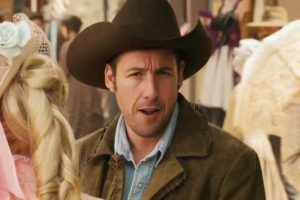
The Ridiculous Six: it was ridiculous.
In relation to episode one, set in Fort Calgary, it shows Indians being massacred, villages destroyed, and all around chaos. Hunter even says “…and if I was one of these guys (white men), I’d be ready to kill the savages too.” This shows how the smallest portrayal of people can impact people’s views. Although there has been substantial change in the media world throughout the past few decades to shift perspectives, more needs to be done to unwind people’s minds to show people what exactly happened. Works like Timetraveller is special because people can access it anywhere in the world – you don’t need to attend a typical class to learn about Indigenous history as the web creates endless opportunities. Additionally, this features an interactive platform, which can provoke viewers to create their own episode or character. Secondly, the content is from an actual Indigenous person you get to learn about from a first-hand perspective, not a textbook written by authors you’ve likely never heard. As Erica Lee has described, “In knowing the histories of our relations and of this land, we find the knowledge to recreate all that our worlds would’ve been if not for the interruption of colonization.”[1] This act of #decolonization can also form resurgence partnerships with Indigenous and non-Indigenous people worldwide too. My favourite thing about it is that it allows users to “go back into time” through their avatar and explore the setting. This makes it fun and user-friendly, whereas reading a textbook isn’t that fun and may be misrepresenting Indigenous peoples. For example, the illustration of characters is very realistic as they are created by real Indigenous individuals who bring historical pieces back to life, many of which are still seen today. For example, in episode 2, the men are wearing hunting clothing and carrying weapons that best represent the time and setting and culture they are in.
With that said, getting a perspective from the people themselves from a good reliable source is always crucial. As mentioned in the episode, “always get a second opinion on history.”
If I were to create my own episode, it would be about the #NoDAPL from the perspective of an Elder (in my own opinion). After watching the Oka Crisis episode, I noticed a lot of similarities that played out in movements, such as misrepresentations of Aboriginal people and how they are seen as violent, which is still a common belief many have today. This episode aims to show the Dakota Access Pipeline protest in action:
Main Setting: Sioux Indian Reservation, North Dakota, U.S.
Year: 2121
[Hunter is scrolling through Facebook posts when he notices an old article about DAPL]
Hunter: hmm, time for some entertainment. Timetraveller on. Search Standing Rock Indian Reservation in North Dakota. I am curious about what it was like there. Let’s go there and see what’s happening. I wonder if it’s any different than the 1990 Oka incident. I wish I could be there to show the military a thing or two. Maybe even make the 6:00 news.
[Puts on goggles and goes to Standing Rock after ‘checking in’ on Facebook]
Upon arrival, sounds of weapons firing, people yelling, and chaos is heard. Hunter approaches an Elder and asks what is happening.
Hunter: Fucking hell. You’d think things would have changed by now after the 1990 Oka ‘Crisis’, but nope.
Elder: they are firing rubber bullets at people. There have already been over 300 people that have been injured and 26 are in the hospital, but we won’t give up.[2] These are our lands, you see – the Mother Earth is, the grandmother of everything, and the water is her blood, and to this blood, we live.[3]
Hunter: We must protect the land. Enough is enough. I’ve come to stand in solidarity with everyone to support everyone.
Elder: watch out! [rubber bullets fly by]
Hunter: [yells]. I’ve had enough of this. This is just the beginning. The violence this has caused is intolerable. How can the governor think that he can just treat Native American’s as lesser citizens? Not to mention the military, police, etc. who are treating people like garbage. This brings flashbacks of Oka.
Elder: you know the difference I see between this and Oka? There is much more support from white people. My daughter showed me a Facebook page called ‘Stand with Standing Rock’ and there are over a million check-in’s, virtual and in real life. Back then, the internet and this support didn’t even exist. There are even videos from our people that are explaining why this land is important, so it opens up more space for our people to speak.
Hunter: I guess you are right. Technology has played a huge role the stand-off. How do you see this playing out?
Elder: We will fight till the end. With global warming now, I think more citizens are seeing the devastation development can cause to Mother Earth. All we want is clean water, is that too much to ask? We have nothing left except this land. The rest has been taken away by the state. As water protectors, we will not leave until we are heard and justice is served. Temperatures are quickly dropping now, but people like Jane Fonda reminded me yesterday that there is so much hope because there is so much support, and that continues to grow globally. She said there are people from Equator, China, you name it. This is how crazy the internet can be in making people join the stand-off. People like her are allies who continue to bring attention to this issue.[4]
Hunter: wow, that is amazing. I think the power of technology is growing more than I can keep up. [time travels back to 2121]
I hope in 2121 things will have changed significantly. The way I see it, our youth continue to be role models and leaders for generations to come, so the world better watch out.
The End.
I was curious if there were any settings about #NoDAPL on Second Life, so I virtually travelled to one called ‘Ethiopia supports #NoDAPL’. People gifted me signs so I could be a part of the movement. The setting mainly consists of the gathering circle (as shown) where anyone can join the circle. However, this was the only #NoDAPL setting I found.
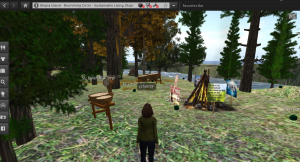
Second Life screen shot 1
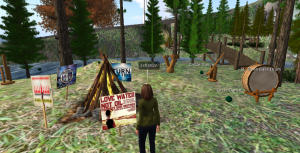
Screen shot 2
Footnotes/references:
[1] http://gutsmagazine.ca/visual-cultures/
[2] http://www.pbs.org/newshour/rundown/army-corps-issues-eviction-notice-standing-rock-protest-camp-tribe-chairman-says/
Lewis, J., & Gragnito, S. T. (2005). Aboriginal Territories in Cyberspace. Cultural Survival Quarterly, 29(2), 29.
[3] Mni Wiconi – Water is Life. https://www.facebook.com/Standing-Rock-Sioux-Tribe-402298239798452/
[4] http://indiancountrytodaymedianetwork.com/2016/11/25/exclusive-jane-fonda-standing-rock-ive-rarely-seen-so-much-love-video-166581
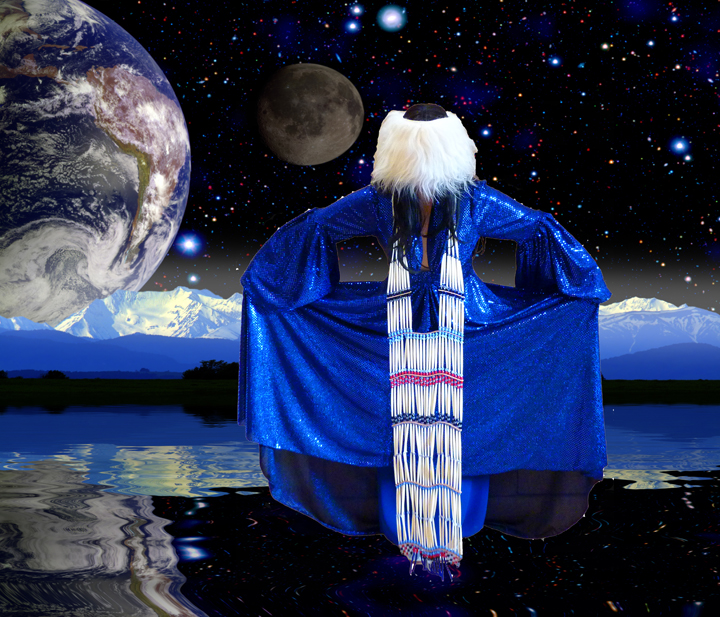
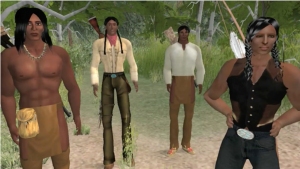
This is a great Timetraveller spec script! Very much in tune with the tone of the original and drawing on important current events. Having Hunter comment on the state of technology (as compared to the Oka episode) was a clever touch as well. Your “Indigenous Futurism” definition is a little off. IF is not only about imagining pre-contact spaces–it is also about looking towards post-contact futures. Good work this term!